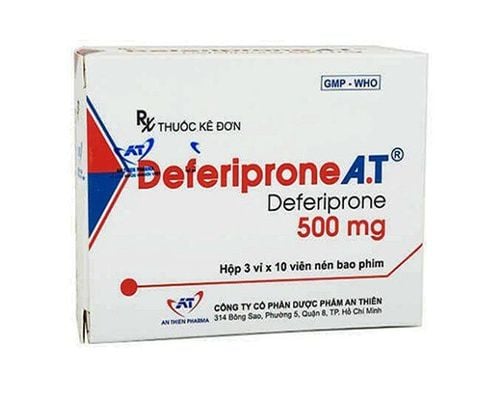This is an automatically translated article.
Desferal drug containing the active ingredient Desferrioxamine is indicated in the treatment of chronic iron overload, idiopathic iron deficiency in patients with concomitant disorders, iron excess related to porphyria... Uses, notes when using Desferal through the article below.1. What effect does Desferal have?
Desferal drug contains the active ingredient Desferrioxamine, prepared in the form of a solution for injection, indicated in the treatment of the following conditions:
Treatment of chronic iron overload through chelation monotherapy, including iron overload in the disease. Thalassemia, hereditary hemosiderin infection, iron deficiency anemia, autoimmune hemolytic anemia and other forms of chronic anemia...; Primary iron hemochromatosis in patients with concomitant disorders such as heart disease, severe anemia, hypoproteinemia...; Iron overload related to porphyria with late skin manifestations in patients who cannot tolerate venous blood extraction; Patients with acute iron poisoning; Treatment of chronic aluminum overload in patients with end-stage renal failure (under maintenance therapy by dialysis) with symptoms; Treatment of bone diseases related to aluminum; Treatment of anemia associated with aluminum; Used in the diagnosis of aluminum or iron overload.
2. Dosage of the drug Desferal
Desferal is administered by infusion as a solution of 95 mg/ml (except for intramuscular injection which may require a higher concentration). Medicinal products in powder form mixed with solution for infusion for intravenous, subcutaneous and intramuscular injection. After injecting distilled water into the syringe, the vial should be shaken well and used only when the solution is clear, the color of the injection solution should be from colorless to pale yellow.
The drug powder after being reconstituted into a solution with a concentration of 95mg/ml can be further diluted with commonly used infusion solutions such as Glucose 5%, NaCl 0.9%, ringer - lactase solution, solution. ringer solution...
For the treatment of chronic aluminum overload or the Desferal trial, using 5.3ml of Desferal solution mixed in a 500mg vial is the appropriate dose (5mg/kg) in a patient weighing 100kg. The specific dose of the drug used depends on the patient's weight, the appropriate amount of Desferal solution is taken from the vial and added to 150ml of physiological saline (NaCl 0.9%).
Desferal solution can also be used as dialysis fluid and intraperitoneally in patients on continuous outpatient or intermittent continuous peritoneal dialysis.
Desferal solution used in the treatment of chronic iron overload by means of a portable infusion pump is described as follows:
Withdraw water for injection into the syringe; Wipe the rubber stopper of the Desferal vial with alcohol, then inject water for injection into the vial, shake the vial again to dissolve the powder; aspirate the drug solution into the syringe, attach one end of the infusion tube to the syringe, connect the other end of the infusion tube to the butterfly needle, inject the fully sealed drug solution into the infusion tube; Place the syringe in the infusion pump. The patient needs to insert the butterfly needle into the lower skin of the abdomen, the skin of the upper leg or the thigh, the arm (the infusion skin must be cleaned with alcohol), the insertion of the needle should be definitive until the wing of the butterfly needle touches into the skin fold that the patient is holding freely with the other hand. The tip of the needle should be moved freely when shaking the needle; Proceed at another location after cleaning the skin with alcohol, fix the needle and bandage. Patients often wear the infusion pump on their body by a shoulder strap or belt. Dosage of Desfenal drug depends on the patient's condition, specifically as follows:
2.1. Treatment of acute iron poisoning Desferal is indicated as an adjunct in the treatment of acute iron poisoning when the patient has one of the following conditions:
The patient is symptomatic with more than symptoms present transient mild (eg, more than one episode of vomiting, soft stools); Patients with significant abdominal pain, lethargy, acidosis or hypovolemia; Patients with positive abdominal X-ray results show multiple X-ray interferences. The recommended dose of Desferal for acute iron poisoning is as follows:
Adults: The first dose is injected intramuscularly 1g, then then repeat 2 doses of 0.5g every 4 hours. Depending on the clinical response of the patient, the dose can be increased by 0.5g every 4-12 hours, the maximum dose is 6g/day. Or can be used intravenously 15mg/kg/hour; Children: Intramuscular dose of 50mg/kg/time every 6 hours, the maximum dose should not exceed 6g/day. Or it can be used intravenously 15mg/kg/hour (not to exceed 6g/day). 2.2. Treatment of chronic iron overload Adults: The recommended dose of Desfenal is 0.5-1g/day intramuscularly or 1-2g/day subcutaneously with a monitoring device.
Children: The recommended dose of Desfenal is 15 mg/kg/hour intravenously (maximum 12 hours/day). Or can be used by subcutaneous infusion of 20-50mg/kg/day with monitoring device.
2.3. Treatment of anemia Thalassemia In case of need, slow intravenous infusion of 2g Deferoxamine for 1 unit of blood (not to exceed 15mg/kg/hour) but not the same IV line as blood transfusion.
2.4. Treatment of aluminum bone disease The recommended dose of Desfenal is 20-40mg/kg per cycle of hemodialysis, the number of doses depends on the clinical condition of the patient.
Note that the dose of Desfenal in treatment needs to be adjusted in patients with renal impairment, usually a 50% dose reduction in patients with creatinine clearance less than 10ml/min.
After intravenous drug administration at a dose of 15mg/kg/hour, if the urinary iron-to-creatinine ratio is greater than 12.5, the patient should continue to be treated with Deferoxamine. Discontinue drug therapy in iron poisoning when urine color returns to normal, serum iron concentration is less than 100 micrograms/dL.
For patients who are not in shock, the intramuscular route is recommended. For patients with cardiovascular collapse or shock should be administered intravenously slowly. Treatment of acute iron poisoning with Desfenal is not recommended by subcutaneous injection.
3. Desfenal side effects
Desfenal medicine can cause some of the following side effects:
Common: Skin side effects such as itching, pain, swelling, rash... Sometimes accompanied by chills, fever and fatigue...
Rare:
Systemic reactions: Anaphylaxis with or without shock, angioedema; Circulatory: Lower blood pressure; Nervous system: Seizures, dizziness, worsening of neurosis in people with aluminum encephalopathy; Skin and soft tissue: Rash, pruritus, urticaria; Liver: Increased liver enzymes; Digestive system: Vomiting, nausea, diarrhea, abdominal pain; Eyes: Night blindness, blurred vision, dark spots, color blindness, retinopathy, optic neuritis, affect the lens and cornea...; Ear: Hearing loss, tinnitus; Unexplained side effects: Thrombocytopenia, irreversible anemia, paresthesias, peripheral sensory disturbances, impaired liver function, dyspnoea, renal failure, cyanosis...
4. Notes when using Desfenal
Contraindications:
Desfenal is contraindicated in patients with hypersensitivity to Desferrioxamine or to any of its ingredients. Precautions for use:
Rapid intravenous infusion of Desfenal may lead to hypotension and shock with symptoms such as tachycardia, facial flushing, urticaria, circulatory collapse... Hearing loss and Vision: High doses of Desfenal (especially in patients with low plasma ferritin levels) may lead to hearing and vision disturbances. Risk of renal failure: About half of the metal complexes are excreted by the kidneys in patients with iron overload with normal renal function. Desfenal should therefore be used with caution in patients with severe renal impairment, as the elimination of metal complexes may be increased by dialysis in patients with renal impairment. Children: Children under 3 years of age Desfenal treatment has been associated with growth retardation. Therefore, it is important to distinguish the risk of growth retardation associated with excessive doses of Desfenal and growth retardation due to iron overload. Dosages below 40 mg/kg have been shown to very rarely cause growth retardation. Acute respiratory distress syndrome has been reported during treatment with high dose intravenous Desfenal in patients with acute iron poisoning, Thalassemia. Therefore, do not exceed the recommended daily dose of Desfenal. Risk of Infection: An increased risk of infection has been reported with treatment with Desferal. Risk of heart failure with high doses of vitamin C: A decline in cardiac function has been reported in patients with severe chronic iron overload when treated with Desfenal concomitantly with vitamin C. Reversible cardiac dysfunction. upon discontinuation of vitamin C therapy. Therefore, vitamin C supplementation is not recommended in patients with heart failure. In patients with aluminum-associated encephalopathy, treatment with high doses of Desferal may aggravate neurological dysfunction. Pregnant and lactating women: Do not treat with Desfenal.
5. Drug interactions
Concomitant use of Desfenal and Prochlorperazine may lead to temporary impairment of consciousness. Concomitant use of Desferal and vitamin C at doses higher than 500 mg/day in the treatment of chronic multifactorial iron overload may lead to decreased cardiac function (reversible with discontinuation of vitamin C). Desfenal may falsify Galli-67 results due to rapid urinary excretion of the Galli-67 complex bound to Desfenal. Therefore, Desfenal 48 should be discontinued prior to scintigraphy. The article has provided information about the uses, doses and precautions when using Desfenal. To ensure safety for your health and maximize the effectiveness of your treatment, you need to take Desfenal exactly as directed by your doctor.
Please dial HOTLINE for more information or register for an appointment HERE. Download MyVinmec app to make appointments faster and to manage your bookings easily.













